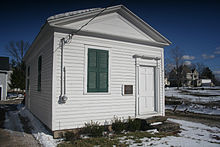
John Brown was an American abolitionist in the decades preceding the Civil War. First reaching national prominence in the 1850s for his radical abolitionism and fighting in Bleeding Kansas, Brown was captured, tried, and executed by the Commonwealth of Virginia for a raid and incitement of a slave rebellion at Harpers Ferry, Virginia, in 1859.

Ashtabula County is the northeasternmost county in the U.S. state of Ohio. As of the 2020 census, the population was 97,574. The county seat is Jefferson, while its largest city is Ashtabula. The county was created in 1808 and later organized in 1811. The name Ashtabula derives from the Lenape language phrase ashte-pihële, which translates to 'always enough (fish) to go around, to be given away' and is a contraction of apchi ('always') + tepi ('enough') + hële. Ashtabula County is part of the Cleveland, OH Metropolitan Statistical Area.

Jefferson is a village in and the county seat of Ashtabula County, Ohio, United States. The population was 3,226 at the 2020 census. It is part of the Ashtabula micropolitan area, 50 miles (80 km) northeast of Cleveland.

Mount Pleasant is a village in southern Jefferson County, Ohio, United States. The population was 394 at the 2020 census. It is part of the Weirton–Steubenville metropolitan area. Founded in 1803 by anti-slavery Quakers, the village was an early center of abolitionist activity and a well-known haven for fugitive slaves on the Underground Railroad.

Eleutherian College, founded as Eleutherian Institute in 1848, was a school founded by local anti-slavery Baptists at Lancaster in Jefferson County. The institute's name comes from the Greek word eleutheros, meaning "freedom and equality." The school admitted students without regard to ethnicity or gender, including freed and fugitive slaves. Its first classes began offering secondary school instruction on November 27, 1848. The school was renamed Eleutherian College in 1854, when it began offering college-level coursework. It closed in 1874 and its main building was used for a private normal school and then a public high school. It is now home to a non-profit group. The school was the second college in the United States west of the Allegheny Mountains and the first in Indiana to provide education to students of different colors. The restored three-story stone chapel and classroom building was constructed between 1853 and 1856 and presently serves as a local history museum. The school was listed on the National Register of Historic Places in 1993 and declared a National Historic Landmark in 1997,
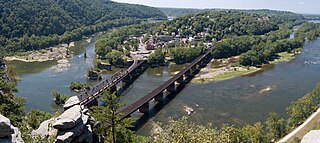
Harpers Ferry National Historical Park, originally Harpers Ferry National Monument, is located at the confluence of the Potomac and Shenandoah rivers in and around Harpers Ferry, West Virginia. The park includes the historic center of Harpers Ferry, notable as a key 19th-century industrial area and as the scene of John Brown's failed abolitionist uprising. It contains the most visited historic site in the state of West Virginia, John Brown's Fort.
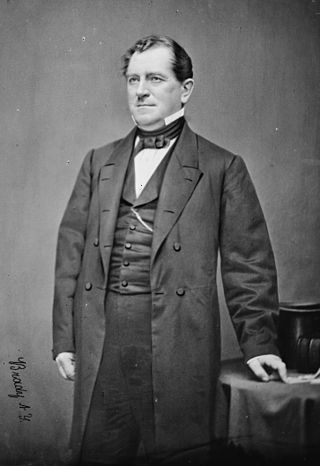
Joshua Reed Giddings was an American attorney, politician and abolitionist. He represented Northeast Ohio in the U.S. House of Representatives from 1838 to 1859. He was at first a member of the Whig Party and was later a Republican, helping found the party.
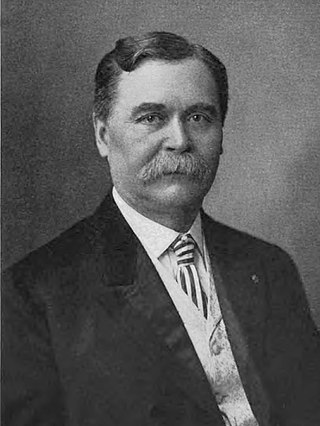
Elbert Leroy Lampson was a notable figure in Ohio politics and public affairs during the second half of the nineteenth century. Hailing from Jefferson, Lampson was the 21st lieutenant governor of Ohio and former State Senator. A lawyer by profession, his time had been taken up with a diversity of interests. He was a banker, and for many years was a newspaper publisher.

Betsy Mix Cowles was an early leader in the United States abolitionist movement. She was an active and influential Ohio-based reformer, and was a noted feminist and an educator. She counted among her friends and acquaintances people such as Frederick Douglass, William Lloyd Garrison, Henry C. Wright, and Abby Kelley Foster.

The Old Jeffersonville Historic District is located in Jeffersonville, Indiana, United States. It marks the original boundaries of Jeffersonville, and is the heart of modern-day downtown Jeffersonville. It was placed on the National Register of Historic Places in 1983. The area is roughly bounded by Court Avenue at the North, Graham Street on the east, the Ohio River at the south, and Interstate 65 at the west. In total, the district has 203 acres (0.8 km2), 500 buildings, 6 structures, and 11 objects. Several banks are located in the historic buildings in the district. The now defunct Steamboat Days Festival, held on the second weekend in September, used to be held on Spring Street and the waterfront. Jeffersonville's largest fire wiped out a block in the historic district on January 11, 2004, which destroyed the original Horner's Novelty store.

Ashtabula County Courthouse Group is a registered historic district in Jefferson, Ohio, listed in the National Register in 1975.

Oakland Memorial Chapel is a historic church and academic building on the campus of Alcorn State University in rural southwestern Claiborne County, Mississippi. Built in 1838 as part of Oakland College, it is one of the oldest surviving buildings at Alcorn State, which took over that defunct school's campus after the American Civil War. Alcorn State was the first land grant university established specifically for the education of African Americans. The chapel was designated a National Historic Landmark in 1976, and a Mississippi Landmark in 1985.

This is a list of the National Register of Historic Places listings in Ashtabula County, Ohio.

The Benjamin Lundy House is a historic house at Union and Market Streets in Mount Pleasant, Ohio. It was home in 1820 to abolitionist Benjamin Lundy (1789–1839), where he established the influential anti-slavery newspaper The Genius of Universal Emancipation, one of the first anti-slavery publications in the United States. It was designated a National Historic Landmark in May 1974, and was included in the Mount Pleasant Historic District later the same year.

The Marais des Cygnes massacre is considered the last significant act of violence in Bleeding Kansas prior to the outbreak of the American Civil War. On May 19, 1858, approximately 30 border ruffians led by Charles Hamilton, a Georgia native and proslavery leader, crossed into the Kansas Territory from Missouri. They arrived at Trading Post, Kansas, in the morning and then headed back to Missouri. Along the way, they captured 11 abolitionist Free-Staters, none of whom were armed and, it is said, none of whom had participated in the ongoing violence. Most of the men knew Hamilton and apparently did not realize he meant them harm. These prisoners were led into a defile, where Hamilton ordered his men to shoot, firing the first and last bullet himself. Five men were killed and five severely wounded. Only one Free-Stater escaped injury.
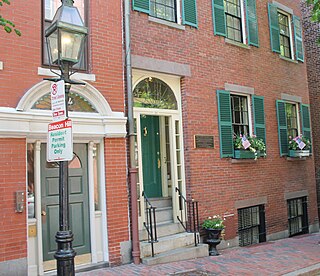
Lewis and Harriet Hayden House was the home of African-American abolitionists who had escaped from slavery in Kentucky; it is located in Beacon Hill, Boston. They maintained the home as a stop on the Underground Railroad, and the Haydens were visited by Harriet Beecher Stowe as research for her book, Uncle Tom's Cabin (1852). Lewis Hayden was an important leader in the African-American community of Boston; in addition, he lectured as an abolitionist and was a member of the Boston Vigilance Committee, which resisted the Fugitive Slave Act of 1850.
The Ohio Women's Convention at Salem in 1850 met on April 19–20, 1850 in Salem, Ohio, a center for reform activity. It was the third in a series of women's rights conventions that began with the Seneca Falls Convention of 1848. It was the first of these conventions to be organized on a statewide basis. About five hundred people attended. All of the convention's officers were women. Men were not allowed to vote, sit on the platform or speak during the convention. The convention sent a memorial to the convention that was preparing a new Ohio state constitution, asking it to provide for women's right to vote.

Benjamin F. Wade House was the home of Civil War-era politician Benjamin Wade. Before its demolition in 1968, it was located at Jefferson, Ashtabula County in Ohio.
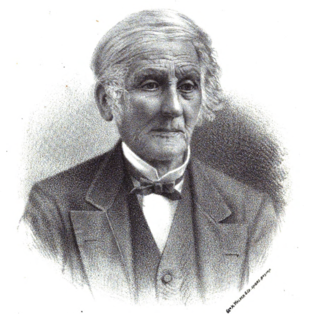
Photius Fisk, also known as Photius Kavasales or Kavasalis, was a Greek-American statesman, botanist, philanthropist, clergyman, abolitionist, and civil rights activist. He is known for lobbying to end flogging in the U.S. Navy. Congress officially passed the law in 1850. The legislation was particularly beneficial to slaves working in the U.S. Navy. Fisk funded countless abolitionist causes and erected several monuments for abolitionists. He had a saffron or bronze complexion. Photius dedicated his life to the poor and destitute.




